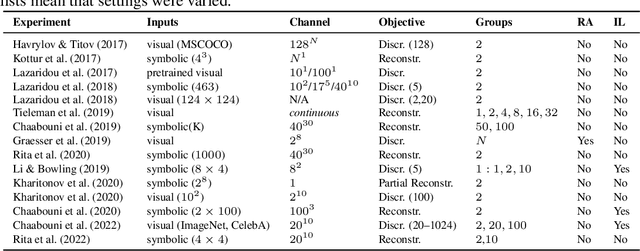Yoav Ram
What makes a language easy to deep-learn?
Feb 23, 2023Abstract:Neural networks drive the success of natural language processing. A fundamental property of natural languages is their compositional structure, allowing us to describe new meanings systematically. However, neural networks notoriously struggle with systematic generalization and do not necessarily benefit from a compositional structure in emergent communication simulations. Here, we test how neural networks compare to humans in learning and generalizing a new language. We do this by closely replicating an artificial language learning study (conducted originally with human participants) and evaluating the memorization and generalization capabilities of deep neural networks with respect to the degree of structure in the input language. Our results show striking similarities between humans and deep neural networks: More structured linguistic input leads to more systematic generalization and better convergence between humans and neural network agents and between different neural agents. We then replicate this structure bias found in humans and our recurrent neural networks with a Transformer-based large language model (GPT-3), showing a similar benefit for structured linguistic input regarding generalization systematicity and memorization errors. These findings show that the underlying structure of languages is crucial for systematic generalization. Due to the correlation between community size and linguistic structure in natural languages, our findings underscore the challenge of automated processing of low-resource languages. Nevertheless, the similarity between humans and machines opens new avenues for language evolution research.
Emergent Communication for Understanding Human Language Evolution: What's Missing?
Apr 22, 2022
Abstract:Emergent communication protocols among humans and artificial neural network agents do not yet share the same properties and show some critical mismatches in results. We describe three important phenomena with respect to the emergence and benefits of compositionality: ease-of-learning, generalization, and group size effects (i.e., larger groups create more systematic languages). The latter two are not fully replicated with neural agents, which hinders the use of neural emergent communication for language evolution research. We argue that one possible reason for these mismatches is that key cognitive and communicative constraints of humans are not yet integrated. Specifically, in humans, memory constraints and the alternation between the roles of speaker and listener underlie the emergence of linguistic structure, yet these constraints are typically absent in neural simulations. We suggest that introducing such communicative and cognitive constraints would promote more linguistically plausible behaviors with neural agents.
 Add to Chrome
Add to Chrome Add to Firefox
Add to Firefox Add to Edge
Add to Edge